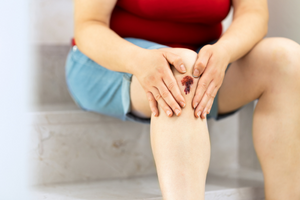08.12.2019
Claim Study
Post-Incident Advice: Top 3 Tips to Use Following a Slip, Trip, and Fall
Visitor slips, trips and falls can lead to significant damage claims with a multitude of factors that can impact potential liability.
A timely and thorough investigation can be key in preserving situational evidence immediately after the event is reported. This initial response can be crucial to the outcome of a claim. While many details can be obtained later, key pieces of evidence often cannot be recreated if not obtained immediately.
While each event warrants an independent investigation, the facility should complete three primary tasks in almost every fall event at the time of response.

Implement These Tasks Immediately
- Take photographs of the scene. It is imperative to photographically preserve the incident scene at the time of the discovery of the event. If the fall allegations involve a rug, a photograph of how the rug was found upon arrival by the responder should be taken. The location of the fall, any obstructions, and warning signs of any potential hazard should be immediately identified and documented.
- Assess the condition of the floor or surface. The responder should visibly note and document, with a photograph, any fluid found at the scene of an event. If no surface fluid is located, this finding should be documented visually as well as through the responder physically touching the surface and confirming their findings. Also, note if the injured person's clothing has any indication of moisture or lack thereof.
- Obtain any witness contact information. Often there is another visitor or patient that may have witnessed the incident. Obtaining this party’s name and telephone number can help to preserve vital potential witness testimony that might otherwise be lost if not immediately obtained.
Need More Resources?
At LHA Trust Funds, we are committed to assisting our members with investigating incidents that occur. If an event has occurred at your facility, we encourage you to contact our claims consulting team.
In addition to responsive assistance, we also provide educational resources to grow and develop your internal incident investigations. Join us for the Writing Occurrence Reports and Conducting Investigations webinar to learn more about producing effective occurrence reports and investigations. In the meantime, check out our Fall Prevention Toolkit for more tips and resources.
If you would like additional information on educational resources regarding incident investigations, please contact a member of our claims or risk management teams.
About the Author

Jamie Lamb
Director of Claims Operations, LHA Trust Funds
Jamie Lamb began her career in claims in 1997. Her experience includes handling multi-line claims in the areas of general liability, medical malpractice, automobile liability, commercial and personal property, excess and umbrella policies, and professional liability. Her experience comes as a former Manager and Litigation Specialist for the American National family of companies. She has been highly involved in the education and training of both internal and external customers her entire career. Ms. Lamb attended both Evangel University in Springfield, Missouri, and Loyola University in New Orleans.
Content Related to this Article
08.15.2022
Article
Your Internal Incident Investigation: Laying the Groundwork for Defense Against Claims
In many instances, the successful defense of a claim depends on the quality of the healthcare facility’s internal investi...
Learn More
09.12.2023
Article
Planning Fall Prevention? The Top 4 Tools To Get You Started
Slips, trips, and falls can cost your healthcare facility in both dollars and reputation. Our LHA Trust Funds risk manage...
Learn More